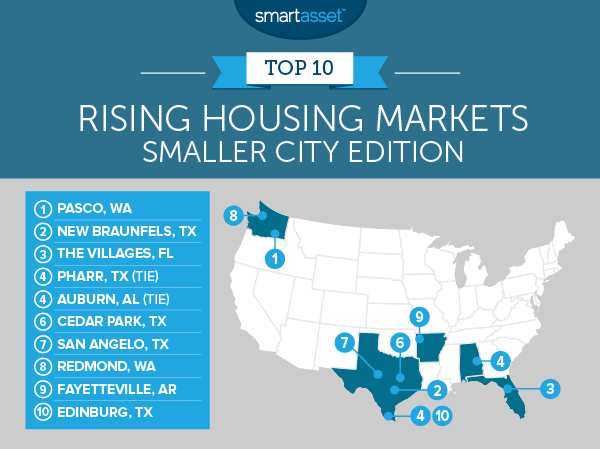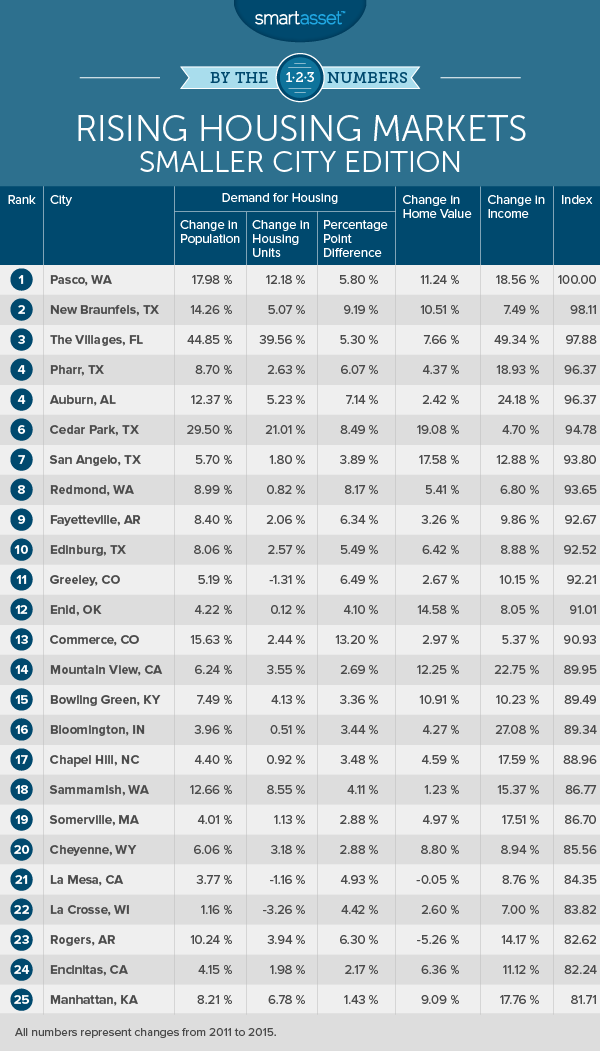Cities like San Francisco and New York tend to dominate the headlines when it comes to exploding housing markets. But there are plenty of smaller housing markets with tons of potential that don’t get the recognition they deserve. These cities contain many of the right ingredients to become a valuable place to own a home. Read on as we look at data on smaller cities across the U.S. that are home to rising housing markets.
Buying a home? Check out our mortgage calculator.
In order to find the smaller cities with rising housing markets, we looked at data on home values, incomes, population size and housing units. Specifically, we looked at data on each of these factors in 2011 and 2015, and then looked at the percent change. To see where we got our data and how we put it together, read the data and methodology section below.
Key Findings
- Texas on top – Just like with the big city edition of our rising housing markets series, Texas dominated the list. Five cities in the top 10 are in Texas.
- College towns – Several cities in the top 25 are college towns. In many smaller cities, universities act as economic hubs supporting the whole community and keeping the economy growing. Auburn, Alabama; Fayetteville, Arkansas; Bowling Green, Kentucky; Bloomington, Indiana and Chapel Hill, North Carolina and Manhattan, Kansas all fit this description.
- Flint at the bottom – The beleaguered Michigan city came in last in our study. Unfortunately for Flint homeowners, home values dropped over 40% on average from 2011 to 2015.

1. Pasco, Washington
Pasco is located in southeast Washington. The Columbia River and the Grand Coulee Dam, which sits on the river, have made Pasco an agricultural powerhouse. This region, including Pasco, has become center for the Washington wine industry. And people have been attracted to the area’s economic activity. From 2011 to 2015 the population of Pasco jumped almost 18%, but over that same period housing stock only grew 12%, meaning the housing demand may be higher than the supply.
2. New Braunfels, Texas
New Braunfels, as you may be able to tell by its name, was originally settled by Germans. This city is home to a few tourist attractions which drive the economy. The German-style festivals held in the town to celebrate its German roots are popular attractions as is the Schlitterbahn Waterpark. In fact, Schlitterbahn is the second-largest employer in the city. From 2011 to 2015, the population rose 9% more than the stock of housing did. This has led housing prices to jump over 10% on average. That gap between new people and new homes may mean home values will keep rising.
3. The Villages, Florida
The Villages, a huge Florida gated community for persons over the age of 55, is known for being a fun and active place where residents take part in activities like water volleyball, archery and golf. The community has seen impressive growth recently. From 2011 to 2015, housing stock shot up 39% and the population grew by a whopping 44.8%. During that time the Villages residents’ median incomes also grew an astonishing 49%.
4. (tie) Pharr, Texas
Pharr is the second Texas city and the fourth-ranked city overall in our top 10. It is located close to the Mexican border and 90% of its population are Hispanic. From 2011 to 2015, the population of Pharr grew 6% more than the housing stock grew, creating a large demand for housing. Combine that with the almost 19% increase in median incomes in Pharr, and you have the recipe for a rising housing market.
4. (tie) Auburn, Alabama
Tied with Pharr for fourth place is Auburn, Alabama. The city of Auburn is located in eastern Alabama and is dominated by Auburn University. The university employs over 5,000 people. From 2011 to 2015, the population grew 7% more than the housing stock did. While that one fact alone is enough to place Auburn on the list of rising housing markets, what is even more impressive is the growth in income. Individual median incomes in Auburn grew 24% from 2011 to 2015, meaning people have extra cash to spend on the housing stock.
6. Cedar Park, Texas
Cedar Park is a suburb of Austin, Texas that has benefited from the Texas capital’s recent growth. With the high housing costs in Austin, many people are looking for cheaper housing and Cedar Park fits the bill. The population here jumped almost 30% from 2011 to 2015 outpacing the housing stock, which grew 21% over the same time period. This extra demand for housing led to home values increasing by over 19% on average. Cedar Park ranks second in our study for median home value growth.
7. San Angelo, Texas
The Oasis of West Texas comes in seventh on our list. This city has seen impressive growth in incomes and housing values. From 2011 to 2015, median home values grew 17.58%. That’s the fourth-fastest rate in the study. During that same period median incomes grew 12.88%, which was the 29th-highest rate in the study.
8. Redmond, Washington
Redmond is best known for being the home of Microsoft. Housing stock in Redmond grew by only 0.82% from 2011 to 2015 – a paltry amount when you consider that the population grew by 9%. Over that same period the city saw median home values grow by 5.41% and median incomes grow by 6.8%. For both of those metrics, Redmond ranks in the top 100.
9. Fayetteville, Arkansas
Fayetteville is home to the University of Arkansas, the largest university in the state. SmartAsset recently found the city is one of the best for working students. Median incomes in Fayetteville grew by around 10% from 2011 to 2015. The population also grew by 8.4%, outpacing the growth in housing stock by 6.3%.
10. Edinburg, Texas
Around 55,000 people call Edinburg, Texas home. The city is also home to a new medical school, University of Texas Rio Grande Valley School of Medicine. Just like in Auburn and Fayetteville, where the higher education complexes support the local economy in a major way, you can expect the new medical school to do the same in Edinburg. From 2011 to 2015, the population grew by 8%. That population increase was 5.5% greater than the increase in housing units, creating an excess demand for housing in Edinburg.

Data and Methodology
In order to find the smaller cities with the fastest-rising housing markets, we looked at data on 498 cities with populations between 50,000 and 100,000, according to 2015 U.S. Census Bureau’s 5-Year American Community Survey estimates. Specifically we looked at:
- Change in median home values. This is the percent change of median home values from 2011 to 2015. Data comes from the 2011 and 2015 U.S. Census Bureau’s 5-Year American Community Surveys.
- Change in median incomes. This is the percent change in individual median incomes. Data comes from the 2011 and 2015 U.S. Census Bureau’s 5-Year American Community Surveys.
- Difference between population change and housing unit change. This is the percentage point difference between the percent change in population and percent change in housing units from 2011 to 2015. Data is from the U.S. Census Bureau’s 2015 5-Year American Community Survey. For example: In Midland, Texas, the population grew by 12.78% and the number of housing units grew by 5.71%, thus the difference between them is 7.07%.
We ranked each city in each metric, giving equal weight to all metrics. We then averaged the rankings. After finding the average ranking for each city, we assigned them a score. The city with the highest ranking received a score of 100 and the city with the lowest ranking received a 0.
Questions about our study? Contact us at press@smartasset.com.
Photo credit: ©iStock.com/BrianAJackson
